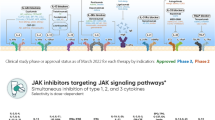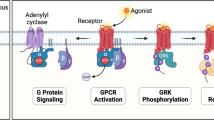Abstract
In the present study different selective inhibitors of the multifunctional serine/threonine kinase protein kinase C (PKC) were investigated on classical activation pathways of basophils in comparison to the nonselective protein kinase inhibitor staurosporine. The potent inhibitors Ro 31-7549, Ro 31-8220, calphostin C and ilmofosine (BM 41.440), which show selectivity for PKCin vitro, significantly potentiated FcεRI-mediated histamine release up to 50% vs. controls at concentrations >10−7 μmol/l but were without any intrinsic histamine releasing activity. Direct activation of cellular PKC by phorbol ester was suppressed by all compounds apart from ilmofosine at the same concentrations. We did not observe statistically significant effects of selective PKC inhibitors on exocytosis induced by the peptide formylmeth-leu-phe (FMLP) or the ionophore A23187, whereas staurosporine potentiated the FMLP-induced histamine release in a dose-dependent fashion: maximum potentiation was 63.5±8.9% vs. control at 1 μmol/l (n=4). The findings suggest that PKC exhibits differential functions during biochemical events of stimulus-secretion coupling in human basophils supposedly by its distinct subtypes. With respect to the present data, TPA-induced and IgE-mediated signals are not closely correlated.
Similar content being viewed by others
References
F. Pearce,Mast cell heterogeneity. InMast Cells, Medicators and Disease (Ed. S. T. Holgate) pp. 175–193, Kluwer Academic Publishers, Dordrecht, 1988.
R. Alam, J. B. Welter, P. A. Forsythe, M. A. Lett-Brown and J. A. Grant,Comparative effect of recombinant IL-1, −2, −3, −4 and −6, INF-γ, granulocyte-macrophage-colony-stimulating factor, tumor necrosis factor-α, and histamine-releasing factors on the secretion of histamine from basophils. J. Immunol.142, 3431–3435 (1989).
J. A. Warner and D. W. MacGlashan,Protein kinase C (PKC) changes in human basophils: IgE-mediated activation is accompanied by an increase in total PKC activity. J. Immunol.142, 1669–1677 (1989).
J. A. Warner and D. W. MacGlashan,Signal transduction events in human basophils. A comparative study of the role of protein kinase C in basophils activated by anti-IgE antibody and formyl-methionyl-leucyl-phenylalanine. J. Immunol.145, 1897–1905 (1990).
Y. Nishizuka,The family of protein kinase C for signal transduction. JAMA262, 1827–1833 (1989).
U. Amon, E. von Stebut, K. R. Dietz, F. W. Bauer and H. H. Wolff,Pharmacological studies on the role of protein kinase C in signal transduction of human basophils. Int. Arch. Allergy Immunol.98, 349–354 (1992).
M. Ennis,Automated fluorometric assays. InHandbook of Experimental Pharmacology. (Ed. B. Uvnäs) pp. 31–38, Springer, Berlin 1991.
F. L. Pearce,Calcium and histamine secretion from mast cells. Prog. Med. Chem.19, 60–109 (1982).
U. Amon and K. R. Dietz,Protein kinase C: A target for anti-inflammatory therapy? Arch. Dermatol. Res.284, 8–10 (1992).
E. F. Knol, L. Koenderman, E. Mul, A. J. Verhoeven and D. Roos,Differential mechanisms in the stimulus-secretion coupling in human basophils: Evidence for a protein kinase C-dependent and a protein kinase C-independent route.Agents and Actions 30, 49–52 (1990).
H. Bergstrand, B. Lundquist, K. Karabelas and P. Michelsen,Modulation of human basophil histamine release by protein kinase C inhibitors differs with secretagogue and with inhibitor. J. Pharmacol. Exp. Ther.260, 1028–1037 (1992).
M. Benhamou, V. Stephan, K. C. Robbins and R. P. Siraganian,High-affinity IgE receptor-mediated stimulation of rat basophilic leukemia (RBL-2H3) cells induces early and late protein-tyrosine phosphorylations. J. Biol. Chem.267, 7310–7314 (1992).
U. Amon, E. von Stebut and H. H. Wolff,Influence of protein kinase C activation on basophils isolated from patients with atopic dermatitis in comparison to non-atopic controls. Dermatology,186, 109–112 (1993).
D. M. Trask, S. C. Chan, S. E. Sherman and J. M. Hanifin,Altered protein kinase activity in atopic dermatitis. J. Invest. Dermatol.90, 526–531 (1988).
B. E. Cantwell and J. C. Foreman,Characteristics of the effect of phorbol ester on rat mast cell: interaction with anti-IgE. Agents and Actions18, 77–80 (1986).
N. Grosman and K. A. Nielsen,The influence of tetradecanoyl-phorbol-acetate (TPA) on histamine release from isolated rat mast cells. Agents Actions24, 40–48 (1988).
J. R. Cunha-Melo, H. M. S. Gonzaga, H. Ali, F. L. Huang, K. P. Huang and M. A. Beaven,Studies of protein kinase C in the rat basophilic leukemia (RBL-2H3) cell reveal that antigen-induced signals are not mimicked by the actions of phorbol myristate acetate and Ca2+ ionophore. J. Immunol.143, 2617–2625 (1989).
E. F. Knol, L. Koenderman, A. J. Verhoeven and D. Roos,Differential activation of human basophils by anti-IgE and formyl-methionyl-leucyl-phenylalanine. Indications for protein kinase C-dependent and-independent pathways. Eur. J. Immunol.21, 881–885 (1991).
U. Amon, E. von Stebut, N. Subramanian and H. H. Wolff, CGP 41251, a novel protein kinase inhibitor with in vitro selectivity for protein kinase C strongly inhibits immunological activation of human skin mast cells and human basophils. Pharmacology (in press).
L. H. Elliot, S. E. Wilkinson, A. D. Sedgwick, C. H. Hill, G. Lawton, P. D. Davis and J. S. Nixon,K252a is a potent and selective inhibitor of phosphorylase kinase. Biochem. Biophys. Res. Commun.171, 148–154 (1990).
E. Kobayashi, H. Nakano, M. Morimoto and T. Tamaoki,Calphostin C (UCN 1028C), a novel microbial compound, is a highly potent and specific inhibitor of protein kinase C. Biochem. Biophys. Res. Commun.159, 548–553 (1989).
H. Grunicke, J. Hofmann, K. Maly, F. Überall, L. Posch, H. Oberhuber and H. Fiebig,The phospholipid- and calcium-dependent protein kinase as a target in tumor chemotherapy. Adv. Enzyme Regul.28, 201–216 (1989).
M. Shoji, R. L. Raynor, W. E. Berdel, W. R. Vogel and J. F. Kuo,Effects of thioether phospholipid BM 41.440 on protein kinase C and phorbol ester-induced differentiation of human leukemia HL60 and KG-1 cells. Cancer Res.48, 6669–6673 (1988).
Author information
Authors and Affiliations
Rights and permissions
About this article
Cite this article
Amon, U., von Stebut, E. & Wolff, H.H. Pharmacological investigations with different protein kinase C inhibitors on IgE-dependent and IgE-independent activation of human basophils. Agents and Actions 39, 13–19 (1993). https://doi.org/10.1007/BF01975708
Received:
Accepted:
Issue Date:
DOI: https://doi.org/10.1007/BF01975708




